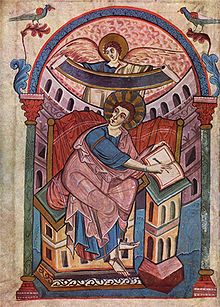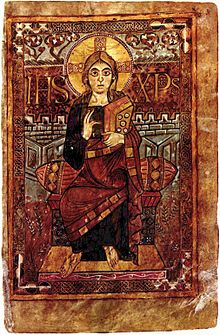Ada group


A painting school of Carolingian book illumination is called the Ada group or court school of Charlemagne and is named after a major work, the Ada manuscript from around 790 . The Ada manuscript served as a template for a number of manuscripts, so that these manuscripts are combined into the so-called Ada group. The Ada handwriting thus gave important artistic suggestions and impulses, which subsequently contributed to the development of a common style.
Localization
The court school was active in the court environment in Aachen . In the past, localization in the Reichskloster Fulda or the Reichskloster Lorsch was also considered .
style
The manuscripts of the Ada group have in common the conscious examination of the ancient heritage and a consistent pictorial program. They are presumably based primarily on late antique models from Ravenna . In addition to magnificent arcades imitating architectural motifs or precious stone-adorned picture frames and insularly-influenced decorative initial pages, the furnishings include large evangelist pictures, which have varied a basic type many times since the Ada manuscript . For the first time since Roman times, the figures with clearly contoured internal drawings are given back physicality, the space three-dimensionality through swelling, rich robes. The pictures share a certain fear of emptiness . Extensive throne landscapes fill the pages with images of the evangelists. At the same time and probably in the same place, the so-called palace school of Charlemagne, which created the group of the Viennese coronation gospel , was active. Byzantine illuminators , whose style differed greatly from that of the court school, probably worked in this painting school .
Works
The first magnificent manuscript that Karl commissioned between 781 and 783, i.e. immediately after his trip to Rome, was the Godescalc Evangelistary named after his scribe . It is possible that this work was not yet created in Aachen, but in the royal palace of Worms . The large initial page, decorative letters and part of the ornamentation come from the island , but nothing is reminiscent of Merovingian book illumination . The novelty of the illumination are the decorative elements taken from antiquity, plastic-figurative motifs and the font used. The full-page miniatures - Christ enthroned, the four evangelists and the fountain of life - strive for real corporeality and a logical connection to the depicted space and thus set the style for the following works by the court school. The text was written in gold and silver inks on purple-stained parchment.
The first part of the Ada manuscript and a gospel book from Saint-Martin-des-Champs were created around 790 . It was followed by the named also after his clerk, before 795 written Dagulf Psalter , which was given after the dedication poem by Charles himself in order and as a gift for Pope Hadrian I was determined. At the end of the eighth century, the Gospels in Abbeville and London can be added, around 800 the Gospels of Saint Médard in Soissons as well as the second part of the Ada manuscript and around 810 the Lorsch Gospels . A fragment of a Gospel book in London closes the series of illustrated manuscripts from the court school. After the death of Charlemagne, it apparently dissolved. As decisive as its influence was up to then, it seems to have left little mark on the illumination of the following decades. Aftermath can be proven in Fulda, Mainz, Salzburg and in the vicinity of Saint-Denis as well as some north-east Franconian scriptoria.
See also
Individual evidence
- ↑ cf. Wilhelm Koehler: The tradition of the Ada group and the beginnings of the Ottonian style in illumination. In: Wilhelm Worringer (Hrsg.): Festschrift for the sixtieth birthday of Paul Clemen. Cohen, Bonn 1926, pp. 255-272.
- ↑ cf. in addition the delimitation by H. Zimmermann: The Fulda illumination in the Carolingian and Ottonian times. Rohrer, Brno 1910.
- ↑ so F. Oslender OSB: The spiritual world of the Carolingian era in the mirror of their illumination . In: A. Zimmermann, J. Koch: Studies and texts on the intellectual history of the Middle Ages. Volume 1. Brill Archive, 1950, p. 122.
- ↑ Jakobi-Mirwald, p. 238.
- ↑ Katharina Bierbrauer : Illumination. A. Occidental illumination. V. Carolingian book illumination . In: Lexicon of the Middle Ages (LexMA). Volume 2, Artemis & Winkler, Munich / Zurich 1983, ISBN 3-7608-8902-6 , Sp. 841-843 (here Sp. 842).
- ↑ Mütherich 1999, p. 561.
- ↑ London, British Library , Harley Ms. 2788.
- ^ London, British Library, Cotton Clausius BV
- ↑ a b Holländer, p. 248.
- ↑ Mütherich, p. 564.
literature
- Wilhelm Koehler : The tradition of the Ada group and the beginnings of the Ottonian style in illumination . In: Wilhelm Worringer (Hrsg.): Festschrift for the sixtieth birthday of Paul Clemen . Cohen, Bonn 1926, pp. 255-272
- Albert Boeckler : Form-historical studies on the Ada group. Bavarian Academy of Sciences, Phil. Hist. Class treatises NF 42, Munich 1956
- Wilhelm Koehler: The Carolingian miniatures . Volume 2: The court school of Charlemagne. German Association for Art History, Berlin 1958.
- Florentine Mütherich , Joachim E. Gaehde: Carolingian book painting . Prestel, Munich 1979, ISBN 3-7913-0395-3
- Florentine Mütherich: The renewal of the illumination at the court of Charlemagne. In: 799. Art and culture of the Carolingian era. Zabern, Mainz 1999, Volume 3, pp. 560-609.
- Ingo F. Walther, Norbert Wolf: Masterpieces of book illumination. Taschen, Cologne u. a. 2005, ISBN 3-8228-4747-X .
- Harald Wolter-von dem Knesebeck : Godescalc, Dagulf and Demetrius. Reflections on the book artists at the court of Charlemagne and their self-image. In: Peter van den Brink, Sarvenaz Ayooghi (ed.): Charlemagne - Charlemagne. Karl's art. Catalog of the special exhibition Karls Kunst from June 20 to September 21, 2014 in the Center Charlemagne , Aachen. Sandstein, Dresden 2014, ISBN 978-3-95498-093-2 , pp. 30-45.
- Theo Jülich: Questions to the court school. In: Peter van den Brink, Sarvenaz Ayooghi (ed.): Charlemagne - Charlemagne. Karl's art. Catalog of the special exhibition Karls Kunst from June 20 to September 21, 2014 in the Center Charlemagne , Aachen. Sandstein, Dresden 2014, ISBN 978-3-95498-093-2 , pp. 56–73.
- Götz Denzinger: The manuscripts of the court school of Charlemagne. Comments on her picture decorations and ornamentation. In: Peter van den Brink, Sarvenaz Ayooghi (ed.): Charlemagne - Charlemagne. Karl's art. Catalog of the special exhibition Karls Kunst from June 20 to September 21, 2014 in the Center Charlemagne , Aachen. Sandstein, Dresden 2014, ISBN 978-3-95498-093-2 , pp. 108-129.
- Stefanie Westphal: Karl's legacy. On the trail of the court school manuscripts in Carolingian times. In: Charlemagne - Charlemagne. Karl's art. Catalog of the special exhibition Karls Kunst from June 20 to September 21, 2014 in the Center Charlemagne , Aachen. Sandstein, Dresden 2014, ISBN 978-3-95498-093-2 , pp. 130–153.
